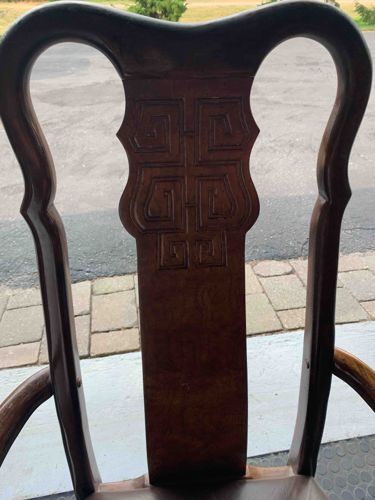
Chinese-style Carved Wood Chair Back
The item is the backrest and portion of the frame of what appears to be a chair, likely an armchair given the visible curve of what could be an armrest joining the back leg. It is constructed from a dark, rich brown wood, possibly mahogany, rosewood, or a similar hardwood, exhibiting a noticeable grain, particularly on the wider central splat. The overall form suggests an Asian influence, specifically Chinese, with its elegant, fluid lines and symbolic carving. The chair back features a prominent central splat that tapers slightly towards the bottom and has decorative, carved contours on its left and right edges. This splat is adorned with an intricately carved geometric pattern, resembling a stylized 'shou' (longevity) character or interlocking key patterns, which is a common motif in traditional Chinese furniture. The carving is precise and appears to be deeply incised, indicating good craftsmanship. The top rail of the chair back is wide and gracefully curved, forming two undulating 'yoke' shapes (hence a possible 'yoke-back' style), which connect to the uprights or legs. The side uprights are also curved, showing a classic 's-curve' or cabriole-like shape which flows smoothly from the top rail down. There are no visible maker's marks or signatures in the image. The wood exhibits a lustrous patina, suggesting age and regular use, with some areas appearing slightly lighter due to wear, particularly along the edges and curves. There are no obvious signs of significant damage such as large cracks, chips, or repairs, though minor surface scratches and indentations consistent with age and use are likely present but not clearly discernible from this single view. The construction appears to be solid, utilizing joinery techniques common in fine woodworking. The style period is likely mid-to-late 20th century repro, or possibly an earlier 19th or early 20th century original, given the quality of the carving and wood. Its robust construction and detailed carving point to a piece of good to high quality.
AI-Generated Appraisal Disclaimer
Estimated Value
$100-200
Basic Information
Category
Furniture - Chair
Appraised On
December 7, 2025
Estimated Value
$100-200
Item Description
The item is the backrest and portion of the frame of what appears to be a chair, likely an armchair given the visible curve of what could be an armrest joining the back leg. It is constructed from a dark, rich brown wood, possibly mahogany, rosewood, or a similar hardwood, exhibiting a noticeable grain, particularly on the wider central splat. The overall form suggests an Asian influence, specifically Chinese, with its elegant, fluid lines and symbolic carving. The chair back features a prominent central splat that tapers slightly towards the bottom and has decorative, carved contours on its left and right edges. This splat is adorned with an intricately carved geometric pattern, resembling a stylized 'shou' (longevity) character or interlocking key patterns, which is a common motif in traditional Chinese furniture. The carving is precise and appears to be deeply incised, indicating good craftsmanship. The top rail of the chair back is wide and gracefully curved, forming two undulating 'yoke' shapes (hence a possible 'yoke-back' style), which connect to the uprights or legs. The side uprights are also curved, showing a classic 's-curve' or cabriole-like shape which flows smoothly from the top rail down. There are no visible maker's marks or signatures in the image. The wood exhibits a lustrous patina, suggesting age and regular use, with some areas appearing slightly lighter due to wear, particularly along the edges and curves. There are no obvious signs of significant damage such as large cracks, chips, or repairs, though minor surface scratches and indentations consistent with age and use are likely present but not clearly discernible from this single view. The construction appears to be solid, utilizing joinery techniques common in fine woodworking. The style period is likely mid-to-late 20th century repro, or possibly an earlier 19th or early 20th century original, given the quality of the carving and wood. Its robust construction and detailed carving point to a piece of good to high quality.
Get Your Items Appraised
Instant estimates of your treasures with AI-powered instant appraisals